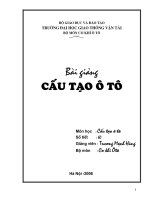BÀI GIẢNG CẦU THÀNH PHỐ
Bạn đang xem bản rút gọn của tài liệu. Xem và tải ngay bản đầy đủ của tài liệu tại đây (13.1 MB, 114 trang )
TRƯỜNG ĐẠI HỌC GIAO THÔNG VẬN TẢI
BỘ MÔN CÔNG TRÌNH GIAO THÔNG THÀNH PHỐ VÀ CÔNG TRÌNH THỦY
MSc. Nguyễn Trọng Nghĩa
Bài giảng:
Cầu thành phố
F1 (Phần 2)
/>
P2
PHẦN 2: NÚT GIAO
KHÁC MỨC
Nội dung chính:
Chương 1: Tổng quan về nút giao khác mức
Chương 2: Tổng quan về cầu cong và cầu chéo trong nút giao
Chương 3: Thiết kế hình học nút giao khác mức
Chương 4: Tính toán và thiết kế cầu cong trong nút giao
P2
PHẦN 2: NÚT GIAO
KHÁC MỨC
Chương 1: Tổng quan về nút giao khác mức
Nút giao khác mức ñược phân loại thành các loại chính sau:
1. Nút giao trên ñường cao tốc
- Nút giao hình viên kim cương
- Nút giao hình quả tạ
- Nút giao hình vòng xuyến
2. Nút giao ngã ba
- Nút giao hình chữ T
- Nút giao hình chữ Y
- Nút giao hình loa kèn
3. Nút giao ngã tư
- Nút giao hoa thị hoàn chỉnh
- Nút giao hoa thị không hoàn chỉnh
- Nút giao nhiều tầng
P2
Motorway to road
interchanges
Diamond Interchange
Chương 1: Tổng quan về nút giao khác mức
The most basic way to connect a road to a motorway
or motorway-style road is a Diamond interchange. It's
quick, it's cheap, it's easy to build and use, and it
demands very little land. One bridge over the top and
four directional sliproads, as simple as that. Their
downfall is their low capacity, and this explains why we
don't have very many in this country. They are
important, though, because most other motorway-toroad junctions are derived from this simple design.
Advantages
Low construction costs, with just one bridge and very
little land-take.
Easy to upgrade later - stick some traffic lights at the
top of the sliproads, for example.
Disadvantages
Low capacity - there's lots of conflicting traffic at the
end of the sliproads.
Hard to substantially upgrade to, for example, a
roundabout interchange.
P2
Motorway to road
interchanges
Diamond Interchange
Chương 1: Tổng quan về nút giao khác mức
P2
Motorway to road
interchanges
Chương 1: Tổng quan về nút giao khác mức
P2
Motorway to road
interchanges
Chương 1: Tổng quan về nút giao khác mức
P2
Motorway to road
interchanges
Chương 1: Tổng quan về nút giao khác mức
overlapped diamond
P2
Motorway to road
interchanges
Chương 1: Tổng quan về nút giao khác mức
Diamond with traffic circle and U-turns
P2
Motorway to road
interchanges
Chương 1: Tổng quan về nút giao khác mức
half diamond
P2
Motorway to road
interchanges
modified diamond
Chương 1: Tổng quan về nút giao khác mức
P2
Motorway to road
interchanges
Dumbbell Interchange – Nút
giao hình quả tạ
Chương 1: Tổng quan về nút giao khác mức
The dumbbell is a hybrid between the
diamond and the roundabout interchange,
which makes it a very close relative of both,
since one is a direct descendant of the
other. In short, it combines the capacity
benefits of a roundabout interchange with
the smaller footprint and single bridge of a
diamond junction.
Advantages
Cheaper than a roundabout interchange,
with just one bridge and less land take.
An easy-to-build step up from the diamond
junction.
Disadvantages
Lower capacity than the roundabout
interchange, with two roundabouts working
less skilfully than one.
Often installed today where a larger
roundabout interchange would have been
built before.
P2
Motorway to road
interchanges
Chương 1: Tổng quan về nút giao khác mức
P2
Motorway to road
interchanges
Chương 1: Tổng quan về nút giao khác mức
P2
Motorway to road
interchanges
Roundabout Interchange
Chương 1: Tổng quan về nút giao khác mức
If you've read up on diamonds you'll know that
they are the simplest way of grade-separating a
junction. If you want to increase the capacity of a
diamond, you can do a few things. America and
Germany, who employ countless diamonds, use
traffic lights. But here, we do the true British thing,
and add a roundabout into the equation. The result
is the most common type of grade-separated
junction in Britain - there's more than 570 on the
motorway network alone.
Advantages
Quite cheap to build: the second bridge is the only
significant cost.
Handles large volumes of traffic with ease.
Can be upgraded fairly cheaply by widening the
roundabout and approaches or adding traffic
lights, or even adding a route across the
roundabout.
Extremely simple to navigate.
Disadvantages
Their high capacity often means they are required
to handle unsuitably high levels of traffic.
P2
Motorway to road
interchanges
Chương 1: Tổng quan về nút giao khác mức
P2
Motorway to road
interchanges
Chương 1: Tổng quan về nút giao khác mức
P2
Motorway to road
interchanges
Chương 1: Tổng quan về nút giao khác mức
P2
Three-way
interchanges
Directional T
Chương 1: Tổng quan về nút giao khác mức
If you're looking at terminating one motorway
standard road on another, and you have the
money to do something special, the
Directional T is where it's at. It uses up more
land than a trumpet and involves much more
engineering work too. But with plenty of
advantages over its smaller cousins, and
three flavours to choose from, the Directional
T is worth the investment.
Advantages
Handles high volumes of traffic with ease.
Easy for the motorist to use.
Three designs allow adjustment of the design
to suit almost any situation.
Disadvantages
More expensive than a comparable three-way
junction like the trumpet.
Difficult to build in structural terms.
Difficult to expand or increase capacity.
P2
Three-way
interchanges
Chương 1: Tổng quan về nút giao khác mức
The Directional T comes in three flavours. The original and the one that really is a Directional T - doesn't exist in
this country. In the US it's considered the original and
traditional form
A bit of extra bridge construction allows one route to take
priority, with the other being subordinate and connecting by
left-hand sliproads. This turns it into a Semi-directional T
One more bridge allows the two right-turn sliproads to
cross again, giving priority to one of the turning
movements. This is a Triangle interchange, from its very
symmetrical shape.
P2
Three-way
interchanges
Chương 1: Tổng quan về nút giao khác mức
P2
Three-way
interchanges
Chương 1: Tổng quan về nút giao khác mức
P2
Three-way
interchanges
Y interchange
Chương 1: Tổng quan về nút giao khác mức
P2
Three-way
interchanges
Chương 1: Tổng quan về nút giao khác mức
The trumpet is the most traditional way of grade-separating
a three way junction - this is your basic free-flowing way to
end one road on another. It is the sister of the cloverleaf, as
both hail from the same period of early grade separation in
the 1920s, and as such are heavy on land use and light on
construction work - both use only one bridge.
Advantages
Low construction costs for bridges/underpasses.
On tolled roads (such as the M6 Toll, where numerous
trumpets are found) the trumpet is a cost-effective way of
getting all traffic in one place for toll booths.
Disadvantages
Disorienting to navigate for those driving in the direction that
uses the loop.
Expensive to build in places with high land values, and
leaves a redundant patch of land within the loop.
Scaling down the interchange often results in a more
dangerous interchange - the M6 at Stoke frequently suffers
congestion from articulated lorries that have tipped over.
A trumpet interchange
P2
Three-way
interchanges
Chương 1: Tổng quan về nút giao khác mức
A trumpet interchange









